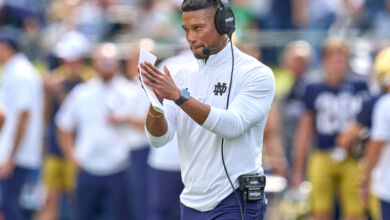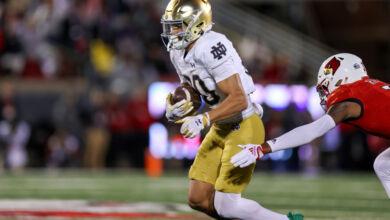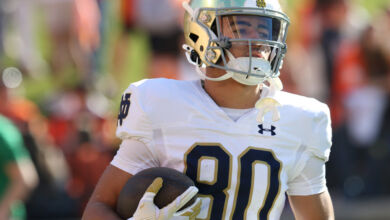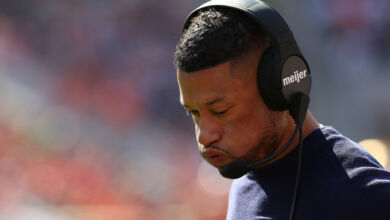Special To UHND.com
While doing research for the documentary, Echoes Awakened: The Year That Changed The Face of Notre Dame Football, I discovered that the subject of the documentary – the 1964 Notre Dame team – and the Fighting Irish of 2009 had a few things in common.
Teams looking for new beginnings after suffering through the two worst eight-season stretches in Notre Dame football history. Six common opponents. Starting quarterbacks who hailed from Southern California and wore the number seven.
The comparisons ended after week two of the 2009 season. Perhaps it’s time they begin again.
Notre Dame’s 1964 season launched the eleven-year run that was “the era of Ara” in South Bend. Having inherited a team that went 2-7 in 1963, Ara Parseghian changed the culture of the Notre Dame football program and took that same team to within 93 seconds of a then-mythical national championship that was denied on what Parseghian would later call “the worst officiating call in the history of college football.”
Forty-six years later, the Notre Dame coaching job is open again. It probably won’t be for long, as Father Jenkins and Jack Swarbrick seem comfortable in the roles of Father Hesburgh and Father Joyce as the principals making the decision as to who’s next.
No matter who takes the helm in South Bend, the new head coach will be well served to study Parseghian’s arrival at Notre Dame in 1964 for some important lessons – all of which are relevant nearly half a century later – on how the echoes can be awakened:
Embrace the institution. Notre Dame “is what it is.” It will and always will be different than the “States” and “Techs” that have risen to college football prominence. Parseghian recognized that and used the differences to his advantage in building teams that dominated college football for more than a decade.
Immerse yourself in all that is Notre Dame. Parseghian made sure his new staff understood what Notre Dame was all about. He brought in books about the university for newcomers to read and encouraged the staff to take an active role beyond football in university events. When students came to his office and asked him to appear at an impromptu pep rally in the middle of February, the new coach dropped what he was doing and led the cheers himself.
Surround yourself with the best and brightest minds in the game. Parseghian assembled an all-star staff – retaining key members from the previous staff for the sake of continuity and bringing in innovators on both sides of the ball in backfield coach Tom Pagna and defensive coach John Ray. No team ever caught up with the creative schemes Notre Dame rolled out every week in 1964 – schemes for which the head coach was quick to give credit to his assistants.
Ignore the past. The new coaching staff never looked back during their first year in South Bend. What happened before Ara’s arrival – including the four wins Parseghian-coached teams at Northwestern posted against the Irish – were part of history. The same went for the idea that players had been recruited to play one position. No fewer than 17 players were moved during spring practice in 1964 – many of whom were the impact players who led Notre Dame to nine consecutive wins.
Walk in with a plan. It would be an understatement to say that the bar has been set high for Notre Dame football. Paresghian understood that. His first year in South Bend was carefully planned so as to change the culture that had permeated the program since the mid-1950’s while empowering the same players who had been on losing teams to be morphed into big winners in his first season.
Surprise the world. Parseghian stunned everyone with the game plan he unveiled in the 1964 opener at Wisconsin. Game plans based on repeated line plunges were replaced by a balanced attack that led to a Heisman Trophy for John Huarte, while the “bend but don’t break” defensive philosophy was trashed in favor of John Ray’s aggressive 4-4-3 blitz-filled scheme that wreaked havoc on opposing quarterbacks.
Some will say that Notre Dame’s history as a college football power will be an albatross around the neck of the next coach – that there is no way Notre Dame can return to the top of the college football world.
In this instance, history need not be a burden. In fact, it bears repeating.
And whoever takes the reins in South Bend need not look very far to find the story of how it can be done and done quickly.
###
NOTE: Bill Flesher is the producer of Echoes Awakened: The Year That Changed The Face of Notre Dame Football, a documentary and DVD that profiles Ara Parseghian’s arrival at Notre Dame and the Fighting Irish’s 1964 season. The documentary and DVD is available at www.echoesawakened.com.




wow, good work on your article!
Kelly hired
Ianello just left for Akron. I wish him the best, but that is going to hurt recruiting.
Very well written.
Yeah, why worry about the burden of ND history, the severance pay is outstanding.
I really wish I had lived in the Ara-Era. At least I remember the Holtz-era!